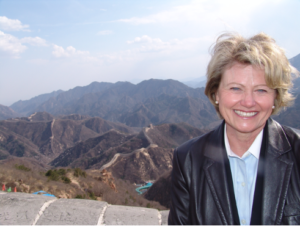Higher Education Diplomacy: Making Connections between the U.S. and China
 Over the course of two years, higher education consultant Susan Frost shuttled between the U.S. and China 16 times, all in the name of forging closer connections between the two countries’ top universities.
Over the course of two years, higher education consultant Susan Frost shuttled between the U.S. and China 16 times, all in the name of forging closer connections between the two countries’ top universities.
“Our system of higher education has a lot to offer the Chinese—they are very interested in introducing the liberal arts into their curriculum and producing graduates who are trained to think creatively and ask questions,” says Dr. Frost, a former vice provost and vice president of strategic development at Emory University.
“When you talk to groups of faculty, there’s a real energy among those who are younger. They’re interested in providing an open education with much more of an edge — they are not in the habit of dampening questions.”
While China is still a one-party government, it is evolving in its tolerance for public dissent and criticism, and higher education is changing as well. In her talks with Chinese officials, Frost has seen firsthand that they understand the importance of a liberal education and seek to infuse critical thinking and civil debate into the educational system.
“Contrary to their predecessors, community leaders now hear from discontented citizens and are realizing that they need to learn how to manage conflict effectively,” she says. “These leaders know that the ‘freedom to disagree’ is a hallmark of Western society, and they want to learn more about how to lead in this new context.”
Technology has hastened this change. Now that the Internet is a common tool, residents are objecting to things that happen in their communities, and public officials are getting a crash course in how to lead in the face of conflict.
Frost has noted a few other positive changes as well. She has met a number of female leaders in her travels who have considerable authority. In addition, there is more interest in religion than one would imagine. One department of the government is now devoted to the management of religious affairs, and the leader is charged with encouraging spiritual expression and promoting interreligious understanding. In her travels, she has visited cathedrals, mosques, Buddhist monasteries, Hindu temples, and many church services.
While many rural areas still operate as they did hundreds of years ago (“When you get behind somebody with an ox on the road, travel takes a long time”), Chinese cities are amazing engines of progress, Frost says.
“They have an incredible capacity to plan and create the physical infrastructure they need, and usually finish it on time,” she says. “I’ve toured several medical schools, research facilities, hospitals, in addition to the new higher education towns. The leaders are eager to learn how to manage medical systems, to improve medical care for the population. I think the leaders know that they need more flexible ways to manage a population that big.”
A Chinese scholar she met summed up the situation this way: “China has the hardware of a major society, but not the software—the human resource systems, planning systems, financial systems, and other such processes.”
Opportunities for Higher Education in China
Frost believes that China offers many opportunities for collaborative ventures with U.S. universities and colleges. But it’s critical to keep in mind that China remains very different from the U.S. in ways both large and small
For instance, Suzhou is a university town and its campus is similar to those in the U.S. with students riding bikes, people going in and out of dining halls and bookstores, and professors talking beside fountains. Similarities even extend to the ever-present Starbucks, where everyone has their laptop spread in front of them, just like the U.S.
Yet knowledge of and sensitivity to cultural differences is essential. For example, personal relationships are important, and the Chinese develop them as a strategic tool. “Many Chinese view Americans as in too much of a hurry,” Frost says. “We are always trying to get to a goal without focusing on relationships.” She has learned to pay attention to details like this, and as a result, her visits have become even more substantive and rewarding.
“Those who describe China as an onion are right,” says Frost. “One could peel back the layers for years and continue to find new insights. One advantage I’ve had in recent years is to discover the “new China” with the help of academic contacts who are just as interested as I am in forging new connections. This is a historic time for higher education, and the possibilities are endless.”
“Recently a Chinese leader told me that there are 350,000 Chinese students in U.S. institutions and only 19,941 U.S. students in Chinese institutions. And of course, far fewer U.S. faculty members have spent time in Chinese universities. It is a real pleasure to help U.S. leaders, scholars and students improve that imbalance. I believe that robust educational exchange is one of our best routes to greater mutual understanding and new knowledge. I am gratified and encouraged that this work has become an important part of my practice.”